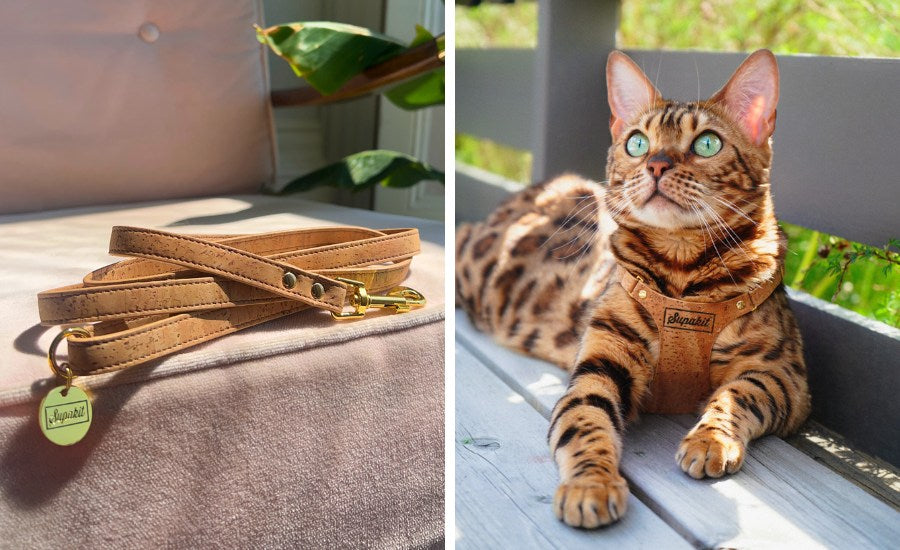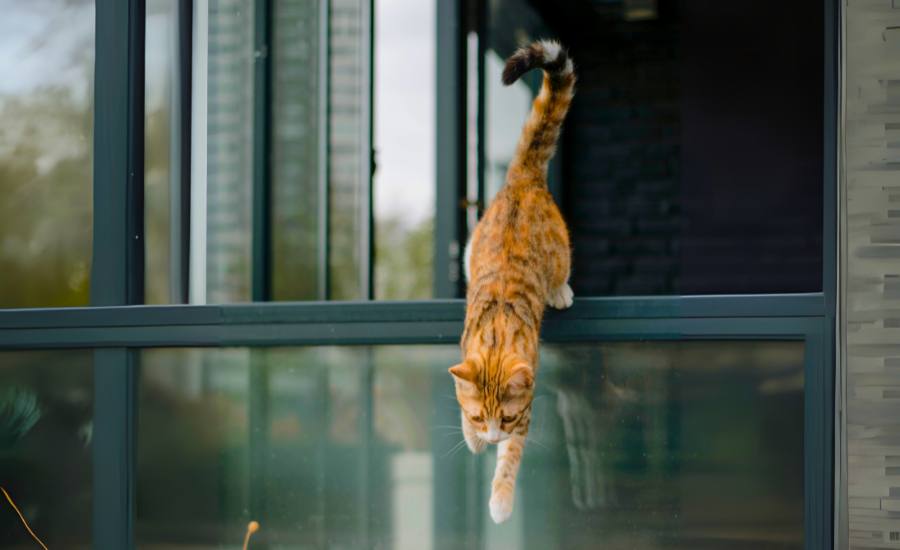Ask the Cat Psychologist - With Kim Houston
If there's one thing we can all agree on, it's that we want to keep our kitties calm, cool and collected. But what's the best way to do that?
Thankfully, we were lucky enough to have the wonderfully knowledgeable Kim Houston join us for our latest #CatChat! Kim, from CAT-astrophes, is a cat psychologist and author who consults with cat owners to resolve behaviour problems with a holistic, positive and education-based approach - all with the help of her 6 kitties, GiGi, Ralph, Brodie, Grace, Hewey and Vera!
Meet The Expert: Cat Psychologist Kim Houston
We were delighted that Kim could join us for our latest #CatChat! Before she answers all your questions, we wanted to know a little more about her...
Q: How did you end up being a cat psychologist?
Kim: As a young child I grew up with so many different types of animals, and always had a calling to work with them. I did consider becoming a vet, but the thought of having to put an animal to sleep (for ill health or behavioural reasons) made me rethink my career options. I believe that if I had carried on down this route, I would have ended up with 100s of rescued animals living in my home! So I pursued a career in human Psychology, and after graduating with a first class degree, decided on embarking on a post-graduate degree in animal behaviour/psychology; after all, animals are far more interesting (and cuter!) than people?! This meant that I could still help animals (and their owners) without having to intervene medically; it was purely from a psychologist/behaviourist perspective.
Once I had graduated, I decided to specialise in cats, because they intrigued me so much. Their sheer determination to survive and amazing ability to hide their feelings (even when feeling physically and psychologically sick) increased my desire to work with this incredible species so much more. After seven years at University, there was much more training and clinical experience that I had to acquire before I could become a member of many forefront organisations such as the Association of Pet Behaviour Counsellors (APBC), and the Association for the Study of Animal Behaviour (ASAB). It was at this point that I could class myself as a Certified Clinical Animal Behaviourist, and one solely specialising in cats. I have now been a cat behaviour consultant running my own busy feline behaviour practice for over 15 years and couldn’t be happier!
Q: What are the most common misconceptions people have about cats?
Kim: Cat owners often view their cats as aloof, solitary and self-reliant individuals who have little in the way of needs and can cope quite happily ‘home alone’ all day whilst the owner is out at work. Contrary to popular belief, cats do have physical, emotional, and psychological needs and requirements. If these are not fulfilled it can lead to physical and behavioural problems, and a very unhappy cat!
Related post: 'How To Keep Your Cat Happy At Home'
Q: What's the most challenging part of your work?
Kim: The most challenging part about my work as a cat psychologist, is not actually the cats per se, it’s actually trying to get the owners on board from the outset. There are no simple quick fixes to eradicating feline behavioural issues – this often requires a lot of time and effort on the owner’s part. If I cannot gain owner compliance then it is very difficult to get the cat back on track. It is sometimes a real challenge to convince owners that my techniques will work (some are rather odd!) but having a degree in human psychology is certainly a bonus!
Q: What's the most rewarding part of your work?
Kim: I see so many unhappy and behaviourally challenged cats, and the most rewarding part of what I do is seeing them become happy and problem free, whilst easing the owners worries at the same time. It’s lovely to be able to help them to get their lives back on track, and to bring back the harmony between the cat and the owner.
Q: What's your number one tip for someone thinking about getting a cat?
Kim: Think very carefully before bringing a cat into your life. It’s a big commitment, and one that can last for up to 20 years. You will need to be able to provide the cat with all that it needs so that it can display normal feline behaviour throughout its life. If you do your research well and are able to give the cat what it really wants and needs, then you will have a wonderful companion, years of happiness together… and heaps of kitty cuddles!
How can we keep our cats calm during fireworks?

The spooky-season is upon us - and while us humans may love the unpredictability and the excitement of fireworks, they're not so much fun for our furry friends!
Thankfully, Kim has helped us out with her top tips for keeping your cat calm during firework season...
Before fireworks begin:
- Plug in a Feliway Diffuser (either Classic or Optimum) in your cat's favourite room
- Provide extra hiding places for your cat to retreat to. For example, you can leave some cardboard boxes around, with an item of your clothing inside to provide some extra security and reassurance if your cat gets scared!
During fireworks:
- Make sure your cat is in the house, and close all windows and doors
- Put the TV or radio on to mask the noise of the fireworks
- Close the curtains and turn on the lamps (to disguise the flashes of light)
- Make sure your cat has clean litter trays
- Stay calm and act normally: your cat will pick up on your anxieties otherwise, and this will make them even more anxious!
After fireworks:
- Leave the Feliway Diffuser plugged in for at least a week
- If your cat is showing signs of continued stress, behaviour therapy may be needed once firework season is over.
Your Cat Questions Answered
Q: I have 3 cats: one for almost 4 years, one for 2 years, and the third just a year. In the last 6 months, my oldest has started aggressively attacking the second cat, even just walking up to her and ripping her fur out. He's never been like this before. Every now and then he'll go for the youngest too, but most of his aggression is towards the middle cat. What can I do to stop this new behaviour?
Kim: I'm sorry to hear that you're having these problems with your cats! The key to keeping peace and harmony in a multi-cat household is to make sure there is enough space and resources for everyone. I'm not suggesting you need to relocate to a larger property, but it does mean you might have to modify the cats' current environment to make it more conducive to multi-cat living. It would be beneficial to do an audit of their environment and look at your home through your cats' eyes.
In essence, you'll need to provide each cat with its own resources, e.g. feeding and water station, litter tray, sleeping area - and these should be positioned in different areas of the house. This should immediately reduce any stress or tension the cats are feeling, as they can associate with each other without the complication of competition for food or space. Please remember that the recommended ratio of litter trays to cats is one litter tray per cat, plus one extra - so for a 3-cat household, there should be 4 litter trays.
Another key factor in obtaining a degree of harmony is to increase the cats' interior territories, which will make it easier for each cat to find personal space. Where possible, add new perches and hideaways to form a range of low, medium and high resting places and escape routes; cat trees and shelving would be ideal.
Finally, enrich the cats' environments by providing a range of food dispensing toys, puzzle feeders, and lots of interactive play. This should further help to ease tensions and will give the cats something to focus on rather than each other. I hope this helps!
Q: A month ago, our kitten (7 months old at the time) was attacked by an unleashed pitbull. She wasn't hurt, but ended up in a bushy tree and then fell 10-15 metres, which was a scary experience too. She is gradually regaining confidence when walking on a leash outside, but is still incredibly scared of dogs. If she sees one, she'll try to run, climb a tree as high as she can, and usually won't let us stop her/pick her up/put her in a backpack. Considering it's almost impossible to avoid dogs and there won't always be a tree nearby, is there a way to calm her around dogs, teach her to trust us more, and find a way we can protect her? Most of the dogs in the area are leashed and friendly and she was doing well at getting used to them and would patiently wait for them to pass, sitting on my hands, or up a tree or on the grass a few metres away. Anything you'd suggest to help her regain her confidence?
Kim: I am sorry to hear about your kitten’s frightening experience with a Pitbull – that must have been very stressful for her, and awful for you to witness. Unfortunately, as a result of this experience, dogs will be perceived as very frightening and negative to her.
In order to change your kitten’s mindset and negative associations in relation to dogs, into associations that are positive, you will need to use two techniques, namely desensitisation and counter-conditioning. These are two behavioural techniques that are particularly useful for eliminating fear and anxiety.
Ideally, you will gradually expose your kitten to a very well-behaved (and cat-friendly) dog in a controlled environment. To do this, you could ask a dog-owner friend to walk their dog (in a very calm manner) at the front of your house, while your kitten is at a distance (on her leash) in your garden. It is very important that we don’t evoke a fearful response; always give her the option to retreat back into the house if she wants to.
The counter-conditioning step is the reward component, e.g., when your kitten displays calm and relaxed behaviour when the dog walks by, reward her with an extra special treat. The treat will act as a reward for being in a ‘perceived’ negative place, e.g. in the vicinity of a dog. However, cats are very rarely motivated to work for their usual daily food ration, so the treats used will need to be of sufficient value that they genuinely represent a reward. It is important to spend a little time experimenting with a wide range of food rewards in order to discover what your kitten really likes, e.g., chicken, prawns, fish, and ham. The chosen reward should only be given when she is calm and relaxed when she sees a dog.
Hopefully, by using this technique, overtime your kitten will begin to associate dogs with pleasurable things, rather than fear. I hope this helps. Best of luck!
Q: My cat tends to chew things, like the edges of my couch or the corners of her wooden cat tree, or any cardboard box around the house. I read about pica, and wondered if the behaviour could be that, but my cat's chewing behaviour isn't as extreme as the examples I read about or constant. When is it diagnosed as pica? And, in general, is there something I can do to discourage him from chewing? He once managed to get a splinter stuck in his gum from chewing the cat tree, which caused some bleeding, and I'm worried about him swallowing plastic or something like that.
Kim: Thank you for your message. Generally speaking, when a cat chews or eats something that is non-edible, e.g., paper, plastics, etc., this behaviour is known as pica. This rather strange behaviour may be a result of genetic predisposition, early weaning, deficiencies in the diet, environmental triggers, stress, or boredom.
You say that your cat’s behaviour is not extreme, which is encouraging, but as you say, he’s already had a splinter stuck in his gums – thankfully this was not stuck in his throat.
Ingesting non-edible foreign objects can lead to serious health problems, such as intestinal blockages, which can be life-threatening and require major surgery. If you haven’t already, it would be a good idea to take your cat see your veterinary surgeon as there could be a medical explanation for his behaviour. If he is given a clean bill of health, then it’s very important to consider his environment.
It might well be that his environment is not enriched and stimulating enough for him.
It would be beneficial to your little boy if you could enrich his environment and provide him with other things to occupy his time. Try introducing regular interactive play sessions with fishing rod toys; 3x10 minutes daily would be a great starting point. Also provide him with puzzle feeders, high-up resting places, and anything else that will enrich his day. It might also help your cat if you provided him something safe to chew on such as a Kong teething stick. These are designed for puppies, but they can be used as a means of providing your cat with a safer alternative to chew. They are a great way of providing additional enrichment and stimulation whilst directing his attention from inedible materials. The Kong teething stick is a durable rubber toy that can be smeared with some tasty cat pate wet food, or a bit of tuna. I am sure he will prefer this to chomping on his cat tree! I hope this helps!
Q: My four month old kitten Momo often likes to curl up under the bed when I'm not home, and sometimes at night to sleep. He always comes out willingly and is very active and social when he's not napping, so I haven't blocked it off as it seems like it's a good escape for him to be alone. But, do you think that this is a sign of anxiety? Should I discourage him from hiding or napping under there and am I enabling bad behaviour by allowing it? Would love your thoughts, thank you!
Kim: Please try not to worry about Momo’s behaviour. It is actually an instinctual behaviour for cats to seek out confined spaces. In the wild, cats get security from confined spaces as they allow the cat to hide from predators. These enclosed spaces also provide an excellent vantage point for the to stalk prey.
Above all else, hiding under your bed offers a safe zone for Momo where he can observe and not be seen. Any predators, other household pets, and even humans will have to come to the front of his field of vision – this leaves no element of surprise to Momo! I think he is a very smart little kitty!!
You could always place a cardboard box in your bedroom to give him an alternative. After all, what cat doesn’t love a cardboard box?! Enjoy your new bundle of fluff and don’t worry!
Q: We are in the process of reintroducing our two fixed male cats, after a redirected aggression incident that led to them not being able to be in the same room without fighting. They have been separated for a little over two months, and we are at the stage of letting them play in the same area. We have two problems: 1) my roommate is unable to keep her cat sufficiently distracted while he knows mine is around, and 2) her cat has gotten more timid during this whole process. This has been especially noticeable over the last week or so as we have been attempting to have them be in the same room. Her cat now jumps at plastic bags, noises from outside, and if we move too quickly - which he never did before. He has always been timid with strangers in the house, but was very confident otherwise, to the point where he would bully my cat - which led to the initial incident. Any idea why he would be getting more timid and what we can do to help him?
Kim: I’m sorry to hear that you’re having a few problems trying to reintroduce your two boys. From what you have said, you have done very well getting them into the same room and playing in the same area. However, due to the fact that one of the cats has become quite anxious, means that you might have gone too quickly for him.
In these types of cases, the best protocol would be to completely separate the cats for a couple of days to allow things to calm down, and at the same time, introduce a couple of products aimed at reducing anxiety. The first is a natural calming product called Zylkene. This product has been shown to be effective at treating stress and anxiety in cats, and therefore will be very useful when trying to reduce, tension, friction and reactivity between the boys.
As an extra measure I would recommend that you also introduce a new and recently launched product called ‘Feliway Optimum’ into your household. Feliway Optimum is a diffuser that is proven to help with more stress-related signs faster than any existing pheromone product. It is shown to be effective in helping to treat a wide array of stress-related issues including multi-cat tensions, conflicts, changes and fears.
Once things have calmed down, and the boys seem less anxious, try to slowly reintroduce them using lots of positive reinforcement. For example, bring them together for a few minutes over something really motivating such as an extra special tasty treat, e.g., small pieces of chicken or ham. I am hoping that this will be enough to distract your roommate’s cat. Take things extremely slowly and reward all positive and calm interactions. Over time the cats should hopefully learn that if they are calm and relaxed in each other’s company then something good will happen, thus associating each other with a positive experience. Good luck!
Related post: 'How To Introduce Cats'
Our next #CatChat...
Huge thanks to Kim for sharing her time and expertise with us! We hope you've all found her tips useful - we've certainly learnt a lot!
Our next #CatChat will be announced shortly, so make sure you're following us over on Instagram to take part.
Related post: 'How To Stop Your Cat From Waking You Up'







